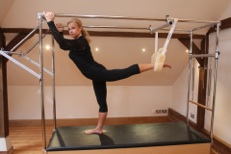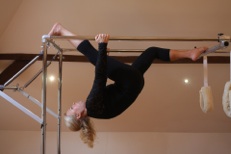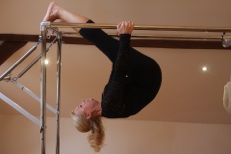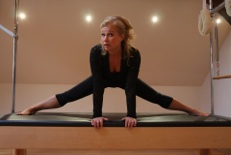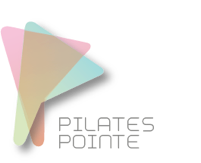Equipment
The Pilates method seeks to develop controlled movement from a strong core and it does this using a range of traditional equipment to guide and train the body. Joseph Pilates used several pieces of equipment to help people "get the method in their bodies". Each piece of equipment has its own repertoire of exercises and most of the exercises done on the various pieces of Pilates equipment make use of springs to provide assistance or resistance. Using springs results in "progressive resistance", meaning the resistance increases as the spring is stretched. The most widely used piece of equipment is the Reformer, but other equipment used in a traditional Pilates studio and at Pilates Pointe include the Cadillac, Wunda Chair, Ladder Barrel, and Step Barrel (Spine Corrector). Lesser used equipment includes the Magic Circle, Guillotine Tower, the Pedi-Pole, and the Foot Corrector.
In contemporary Pilates other props are used, including small weighted balls, foam rollers, balls, rotating disks, and resistance bands. Some of the traditional equipment have been adapted for use in contemporary pilates (e.g. splitting the pedal on the Wunda Chair).
Fully trained equipment teachers will have studied the complete system of equipment exercises and can generally trace their training back to Joseph Pilates through one of his proteges. Modified Pilates breaks the method down into various parts and the order of the exercises varies from lesson to lesson with many changes made to the original exercises.





